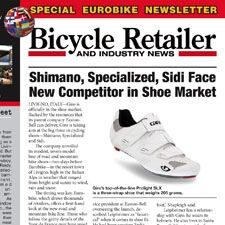FRIEDRICHSHAFEN, Germany (BRAIN)—Giro is officially in the shoe market. Backed by the resources that its parent company Easton-Bell can deliver, Giro is taking aim at the big three in cycling shoes—Shimano, Specialized and Sidi.
The company unveiled its modest, seven-model line of road and mountain bike shoes—two days before Eurobike—in the resort town of Livigno, high in the Italian Alps in weather that ranged from bright and sunny to wind, rain and snow.
The timing was key. Eurobike, which draws thousands of retailers, offers a first-hand look at the new road and mountain bike line. Those who follow the gritty details of the Tour de France may have spied Levi Leipheimer wearing Giro’s pre-production Prolight SLX shoes.
Greg Shapleigh, senior vice president at Easton-Bell overseeing the launch, described Leipheimer as “fanatical” when it comes to shoe fit. He had been wearing Trek’s Bontrager line but switched to Giro after testing the shoes. “He’s fanatical about fit and he doesn’t even have an unusual foot,” Shapleigh said.
Leipheimer has a relationship with Giro; he wears its helmets. He also lives in Santa Rosa, California, not far from Giro’s headquarters near Santa Cruz. That helped get him into the shoes, Shapleigh said. Leipheimer, who just won the grueling Leadville 100, wore Giro’s new Code mountain bike shoes—a pair given to him just three days before he set a new record at Leadville.
But for most in the industry, Eurobike is a chance to check out a new competitor gunning for a share of the $160 million wholesale cycling shoe market. At the same time, the company will take a shot at the general footbed market with its new “Supernatural Fit Kit”—a footbed with three interchangeable arch supports.
Giro is gingerly stepping into the market with just seven models for 2011. In 2012, the line will balloon to 20 models as Giro trickles down its technology and experience into lower price points.
Shapleigh said Giro’s sales force of 40 independent reps in the U.S. market will focus on retailers who embrace the company’s philosophy and technology. Still, aggressive pricing may help convert the undecided.
In general, retailers can expect to make a 50-point margin on the shoes. That could easily increase to 60 points depending upon commitment and volume. “We start at 50 and add on discounts,” Shapleigh said.
To read more about Giro’s strategy as it enters the highly competitive cycling shoe market, click on the PDF link above.
—Marc Sani
msani@bicycleretailer.com




